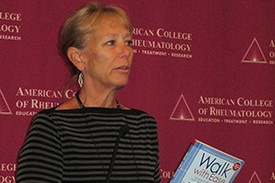User login
SAN DIEGO – A 6-week, low-impact walking program relieved joint pain and stiffness and increased the number of minutes per week walking among elderly breast cancer survivors on aromatase inhibitors.
"A breast cancer diagnosis can be an ‘a-ha’ moment for women," Kirsten A. Nyrop, Ph.D, said during a press briefing at the annual meeting of the American College of Rheumatology. "Some of the women with whom we spoke said: ‘My cardiologist told me to walk and my general practitioner told me to walk, but when my oncologist asked me to walk, I started walking.’ "
Dr. Nyrop, of the Thurston Arthritis Research Center at the University of North Carolina at Chapel Hill, and her associates studied 20 patients who were taking an aromatase inhibitor for stage I-III breast cancer and had self-reported joint pain. The walking program they used was the Arthritis Foundation’s Walk With Ease. The program recommends that participants walk 30 minutes per day at least 5 days per week.
"We wanted to be certain we were reaching these women with a message that would resonate with them and a program that they felt was safe, something that they could comfortably do," Dr. Nyrop said.
The researchers administered visual analog scales (VAS) for joint pain, stiffness, and fatigue, as well as Arthritic Self-Efficacy (ASE) scales for joint and pain symptoms. The mean age of study participants was 71 years, 85% were white, and their mean body mass index was 29 kg/m2.
After 6 weeks in the walking program, researchers noticed improvements from baseline in the VAS pain score (effect size = 0.15) and VAS fatigue score (effect size = 0.22); changes in the VAS stiffness score approached statistical significance (effect size = 0.56). "That’s promising," Dr. Nyrop said. Scores on the ASE scales also improved from baseline for pain and fatigue, but the changes did not reach significance.
Significant increases in walking were observed from baseline in terms of the number of times per week walked (mean increase of 1.9 times; effect size = 0.68), number of minutes per walk (mean increase of 8.3 minutes; effect size = 0.48), and total number of minutes walked per week (mean increase of 62.6 minutes; effect size = 0.53).
One study participant wrote: "I absolutely feel the connection between aromatase inhibitors and exercise. On days I don’t walk, I am stiff, but if I walk, I am not stiff. Keep moving; it really helps."
A larger, follow-up study with a randomized controlled design is underway with funding by the National Cancer Institute.
The study was funded by the University of North Carolina Institute on Aging. Dr. Nyrop said that she had no relevant financial conflicts to disclose.
SAN DIEGO – A 6-week, low-impact walking program relieved joint pain and stiffness and increased the number of minutes per week walking among elderly breast cancer survivors on aromatase inhibitors.
"A breast cancer diagnosis can be an ‘a-ha’ moment for women," Kirsten A. Nyrop, Ph.D, said during a press briefing at the annual meeting of the American College of Rheumatology. "Some of the women with whom we spoke said: ‘My cardiologist told me to walk and my general practitioner told me to walk, but when my oncologist asked me to walk, I started walking.’ "
Dr. Nyrop, of the Thurston Arthritis Research Center at the University of North Carolina at Chapel Hill, and her associates studied 20 patients who were taking an aromatase inhibitor for stage I-III breast cancer and had self-reported joint pain. The walking program they used was the Arthritis Foundation’s Walk With Ease. The program recommends that participants walk 30 minutes per day at least 5 days per week.
"We wanted to be certain we were reaching these women with a message that would resonate with them and a program that they felt was safe, something that they could comfortably do," Dr. Nyrop said.
The researchers administered visual analog scales (VAS) for joint pain, stiffness, and fatigue, as well as Arthritic Self-Efficacy (ASE) scales for joint and pain symptoms. The mean age of study participants was 71 years, 85% were white, and their mean body mass index was 29 kg/m2.
After 6 weeks in the walking program, researchers noticed improvements from baseline in the VAS pain score (effect size = 0.15) and VAS fatigue score (effect size = 0.22); changes in the VAS stiffness score approached statistical significance (effect size = 0.56). "That’s promising," Dr. Nyrop said. Scores on the ASE scales also improved from baseline for pain and fatigue, but the changes did not reach significance.
Significant increases in walking were observed from baseline in terms of the number of times per week walked (mean increase of 1.9 times; effect size = 0.68), number of minutes per walk (mean increase of 8.3 minutes; effect size = 0.48), and total number of minutes walked per week (mean increase of 62.6 minutes; effect size = 0.53).
One study participant wrote: "I absolutely feel the connection between aromatase inhibitors and exercise. On days I don’t walk, I am stiff, but if I walk, I am not stiff. Keep moving; it really helps."
A larger, follow-up study with a randomized controlled design is underway with funding by the National Cancer Institute.
The study was funded by the University of North Carolina Institute on Aging. Dr. Nyrop said that she had no relevant financial conflicts to disclose.
SAN DIEGO – A 6-week, low-impact walking program relieved joint pain and stiffness and increased the number of minutes per week walking among elderly breast cancer survivors on aromatase inhibitors.
"A breast cancer diagnosis can be an ‘a-ha’ moment for women," Kirsten A. Nyrop, Ph.D, said during a press briefing at the annual meeting of the American College of Rheumatology. "Some of the women with whom we spoke said: ‘My cardiologist told me to walk and my general practitioner told me to walk, but when my oncologist asked me to walk, I started walking.’ "
Dr. Nyrop, of the Thurston Arthritis Research Center at the University of North Carolina at Chapel Hill, and her associates studied 20 patients who were taking an aromatase inhibitor for stage I-III breast cancer and had self-reported joint pain. The walking program they used was the Arthritis Foundation’s Walk With Ease. The program recommends that participants walk 30 minutes per day at least 5 days per week.
"We wanted to be certain we were reaching these women with a message that would resonate with them and a program that they felt was safe, something that they could comfortably do," Dr. Nyrop said.
The researchers administered visual analog scales (VAS) for joint pain, stiffness, and fatigue, as well as Arthritic Self-Efficacy (ASE) scales for joint and pain symptoms. The mean age of study participants was 71 years, 85% were white, and their mean body mass index was 29 kg/m2.
After 6 weeks in the walking program, researchers noticed improvements from baseline in the VAS pain score (effect size = 0.15) and VAS fatigue score (effect size = 0.22); changes in the VAS stiffness score approached statistical significance (effect size = 0.56). "That’s promising," Dr. Nyrop said. Scores on the ASE scales also improved from baseline for pain and fatigue, but the changes did not reach significance.
Significant increases in walking were observed from baseline in terms of the number of times per week walked (mean increase of 1.9 times; effect size = 0.68), number of minutes per walk (mean increase of 8.3 minutes; effect size = 0.48), and total number of minutes walked per week (mean increase of 62.6 minutes; effect size = 0.53).
One study participant wrote: "I absolutely feel the connection between aromatase inhibitors and exercise. On days I don’t walk, I am stiff, but if I walk, I am not stiff. Keep moving; it really helps."
A larger, follow-up study with a randomized controlled design is underway with funding by the National Cancer Institute.
The study was funded by the University of North Carolina Institute on Aging. Dr. Nyrop said that she had no relevant financial conflicts to disclose.
AT THE ACR ANNUAL MEETING
Major finding: After 6 weeks in a low-impact walking program, patients experienced improvements from baseline on the visual analog scale (VAS) for pain (effect size = 0.15) and the VAS for fatigue (effect size = 0.22); changes in the VAS stiffness score approached statistical significance (effect size = 0.56).
Data source: A pilot study of 20 patients at the North Carolina Cancer Hospital in Chapel Hill who were taking an aromatase inhibitor for stage I-III breast cancer and had self-reported joint pain.
Disclosures: The study was funded by the University of North Carolina Institute on Aging. Dr. Nyrop said that she had no relevant financial conflicts to disclose.

